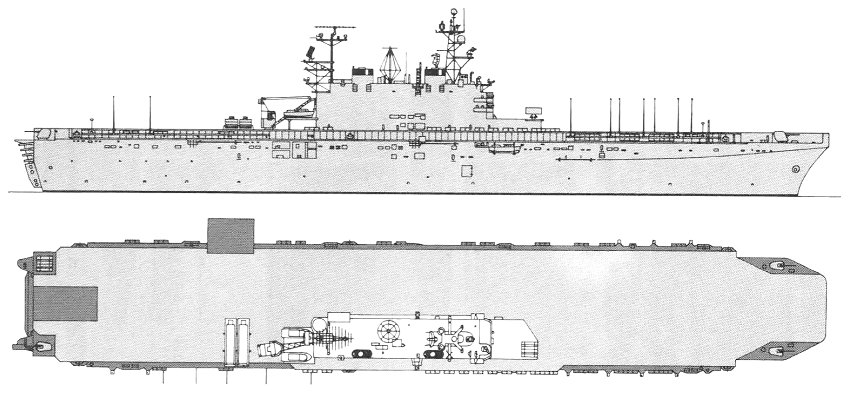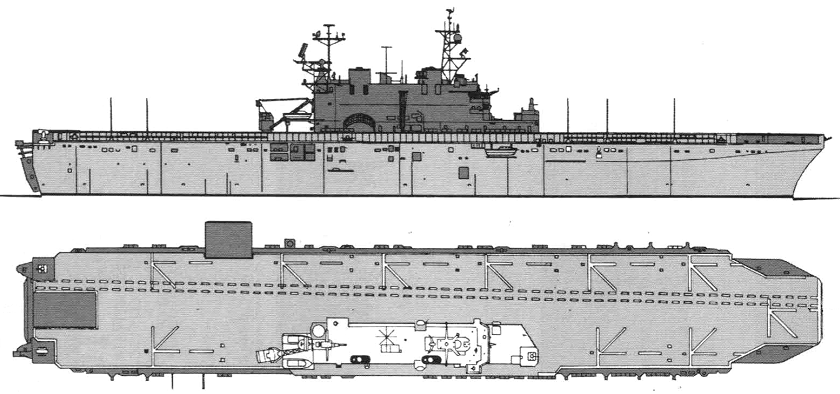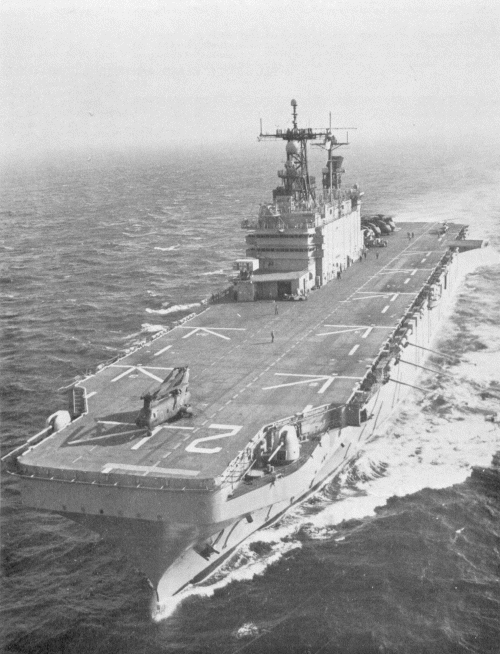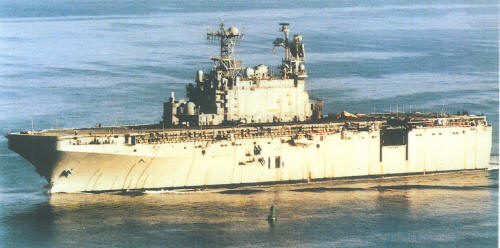

Tarawa 1980

Tarawa 2000
| No | Name | Yard No | Builder | Laid down | Launched | Comm | Fate |
| LHA1 | Tarawa | 4101 | Ingalls, Pascagoula | 15.11.1971 | 1.12.1973 | 29.5.1976 | in reserve (2019) |
| LHA2 | Saipan | 4102 | Ingalls, Pascagoula | 21.7.1972 | 18.7.1974 | 15.10.1977 | stricken 4.2007 |
| LHA3 | Belleau Wood | 4103 | Ingalls, Pascagoula | 5.3.1973 | 11.4.1977 | 23.9.1978 | stricken 10.2005 |
| LHA4 | Nassau | 4104 | Ingalls, Pascagoula | 13.8.1973 | 21.1.1978 | 28.7.1979 | in reserve (2019) |
| LHA5 | Peleliu (ex-Da Nang) | 4105 | Ingalls, Pascagoula | 26.11.1976 | 25.11.1978 | 3.5.1980 | in reserve (2019) |
|
Displacement standard, t |
25884 - 27165 |
|
Displacement full, t |
39438 - 40891 |
|
Length, m |
237.1 wl 254.2 oa |
|
Breadth, m |
32.3 wl 40.2 oa |
|
Draught, m |
8.23 max unballasted |
|
No of shafts |
2 |
|
Machinery |
2 sets Westinghouse geared steam turbines, 2 Combustion Engineering V2M-VS boilers |
|
Power, h. p. |
77000 |
|
Max speed, kts |
24 |
|
Fuel, t |
oil 5900 + aircraft fuel 1200 |
|
Endurance, nm(kts) |
10000(20) |
|
Armament |
2 x 8 Sea Sparrow SAM (16 RIM-7), 3 x 1 - 127/54 Mk 45, 6 x 1 - 20/80 Mk 67, up to 46 aircraft (18 CH-46E, 10 CH-53E, 6 AH-1W, 3 UH-1N helicopters or 6 AV-8B VSTOL attackers, 12 CH-46E, 6 CH-53E, 6 AH-1W, 4 UH-1N helicopters or 20 AV-8B VSTOL attackers) |
|
Military load |
4 LCU1610 or 1 LCAC or 7 LCM(8), 1903 troops, vehicles |
|
Electronic equipment |
SPS-53, SPS-52B, SPS-10F, SPS-40B, SPN-35A, LN-66, SPG-60, SPQ-9A, 4x Mk 95 radars, WLR-1 ECM suite, ITAWDS CCS |
|
Complement |
957 - 1073 |
Project history: These very large assault ships are the final evolution of the helicopter assault concept, combining the functions of LPH, LPD and LKA. They have both a very large flight deck (with spots for twelve CH-46 Sea Knights or nine CH-53 Sea Stallions), a full-length hangar deck (for, respectively, thirty and nineteen such craft), space for a reinforced marine battalion, considerable vehicle and cargo stowage, and a 81.7x23.8x8.1(high)m well deck which can accommodate small craft up to LCU size. Helicopters are handled by two elevators, port folding 20t elevator and aft centerline 40t elevator. There is a complex automated cargo-handling system employing conveyors and elevators, and even a 460m² training and acclimatization room permitting troops to exercise in a controlled environment, so that they can adapt to the climate of their target area en route. Perhaps as importantly, they incorporate substantial command and control facilities, which make up for the shortfall in dedicated amphibious flagships (LCCs). Externally, the emblem of these facilities is the extensive electronic array above the island, including an austere three-dimensional radar (SPS-52) for limited fighter control in the operational area. They have a very complete 352-bed hospital, including 4 operating rooms. Originally they had a boat crane and stowage for landing craft on the flight deck abaft the island, but landing craft were not stored on the flight deck. Vehicle stowage garage fwd of the docking well provides 3134m² of parking space and total capacity of palletized cargo holds is 3311m³. In mine countermeasures role each ship can carry 18 CH-46E, 6 MH-53E helicopters and 6 Mk 105 mine countermeasures sleds.
Conceived in 1965, the Tarawa were ordered under the Concept Definition Contract Formulation procedure which also produced the Spruance class destroyers and the abortive Forward Deployment Ships (FDL). Nine were originally planned, but on 20 January 1971 the Navy announced that LHA6-9 would not be built. From time to time the LHA hull, which is about the same size as a Second World War Essex class fleet carrier, is proposed as the basis for a limited or VSTOL carrier, and in fact at one point Litton reportedly made such a proposal to the Australian government; later it was scaled down to an LPH derivative. There have also been Congressional attempts to convert an existing LHA to a light carrier, with an additional unit being built to replace it.
Typical small craft capacity is four LCU1610 class or two LCU and three LCM-8 or 17 LCM-6, plus forty tracked landing craft (LVT) on the vehicle deck.
LHA 5 was originally to have been named Da Nang, but was renamed Peleliu on 15 February 1978, presumably in view of popular feelings about the Vietnam war and particularly about its conclusion.
Modernizations: 1983-1988, all: - WLR-1 ECM suite; + SLQ-32(v)3 ECM suite, 4x Mk 36 SRBOC decoy RL
early 1980s, Saipan: - 1 x 8 Sea Sparrow SAM, 2x Mk 95 radars; + 1 x 6 - 20/76 Mk 15 Phalanx, Mk 90 radar
early 1980s, Nassau: + 1 x 6 - 20/76 Mk 15 Phalanx, Mk 90 radar
early 1990s, Tarawa, Belleau Wood, Peleliu: - 1 x 1 - 127/54 (port aft); + 2 x 6 - 20/76 Mk 15 Phalanx, 2x Mk 90, Mk 23 Mod. 3 TAS radars
early 1990s, Saipan, Nassau: - 1 x 1 - 127/54 (port aft); + 1 x 6 - 20/76 Mk 15 Phalanx, Mk 90, Mk 23 Mod.3 TAS radars
1995-1997, Tarawa, Belleau Wood, Peleliu, Nassau: - 2 x 8 Sea Sparrow SAM, 2 x 1 - 127/54, 4x Mk 95, Mk 23 Mod.3 radars
1995-1999, all: - SPS-10, SPS-52B, LN-66 radars; + 2 x 21 RAM SAM (42 RIM-116), SPS-67(v)3, SPS-48E, Mk 23 Mod. 3 TAS, SPN-43B, SPS-64(v)9 radars, SLQ-25A Nixie torpedo decoy
1998-1999, all: - 6 x 1 - 20/80, SPG-60, SPQ-9A radars; + 8 x 1 - 12.7/90
early 2000s, all: + 3 x 1 - 25/75 Mk 38 Bushmaster
Naval service: No significant events.

Saipan 1980

Tarawa 2002
© Ivan Gogin, 2016-19